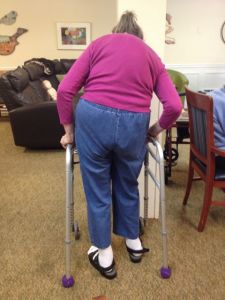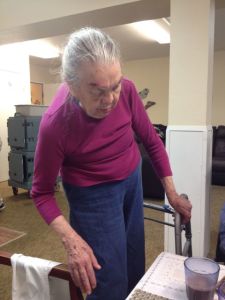
by Diane Masson | May 17, 2015

Drug Restraints and the Haldol Shuffle
Adult children just want their parent with dementia to be okay. Most do not have a clue on psychotropic (mind altering) medications or how they work. Families rely on professionals to recommend doses and medications for their senior parents. If a professional doctor or memory care community says that our mom or dad needs these medications, we tend to accept their wisdom. We are programed to not question authority. Yet when a parent is sedated in a drugged stupor over an extended period of time, more adult children are starting to ask why. At this point it can be too late for a senior with dementia.
Psychotropic medications can have a lasting affect on a senior with dementia.
Seniors may never be able to return to their baseline, before taking psychotropic drugs. My mother-in-law was given Haldol and now does the Haldol shuffle. It is a continuous stand up, walk, sit down and then it starts all over again. It is so sad to watch and they can’t stop. A professional told me it’s like their skin is crawling and they have to keep moving to make the feeling go away.
When we recently brought my mother-in-law her favorite Greek food for lunch, she sat down in front of her favorite foods at the table and then immediately stood back up and started the Haldol shuffle again. She had no desire to eat her favorite foods.
It has taken four months for the family to get her off the Haldol. My sister-in-law had to physically take my mother-in-law to her primary care physician and demand for the Haldol to be discontinued last week. The doctor was shocked my mother-in-law had been on Haldol for such a long period of time, with no recorded outbursts requiring such a strong medication.
So what happened?
My father-in-law, Bill, and mother-in-law, Amy, refused to move from their home of 56 years. Bill had been Amy’s caregiver for the last four years because she had dementia. When Bill had a sudden heart attack and went to the hospital, Amy was in jeopardy in the family home. The local children rallied around the dad in the hospital. For all intensive purposes, Amy was left alone for three days and three nights. My husband and I live 1000 miles away and we hired a geriatric care nurse. Amy was having delusions, not recognizing her own children, making unsafe choices, refusing to take her medications and eloped (she walked away and the police brought her home).
No community would accept her without medications
No assisted living would take her, because she had eloped. A memory care community came to assess whether they would accept Amy and said they would not take her unless she was medicated. The family understood drugs were a requirement at this point. My sister-in-law called Amy’s doctor’s office and explained Amy symptoms of delusions and etc., they did not want her in the clinic. Are you kidding me?!!? Amy’s doctor’s nurse said to take her to urgent care. But according to urgent care she was not bad enough to be admitted to the hospital. They sent her home with five pills of Adavan. Now what? Medications were required live in the memory care community. What could we do? She was not safe at home by herself and she didn’t want her adult children (she no longer recognized) to be with her. Finally a geriatric nurse provoked Amy to hit her. Then the police came and Amy was taken to the hospital by ambulance. There was no room in the psych ward so she was drug restrained in the emergency room for three days and two nights.
So the psychotropic nightmare began
The hospital said strong medication was necessary and started the Haldol. She was in the hospital for three weeks. Both memory care communities said the medications were necessary for Amy too. The family stupidly believed the professionals. Amy’s HMO had poor communication between the doctor, the hospital, the memory care communities and the home health professionals that saw Amy in person.
The first memory care community recommended making no drug changes for one or two months. When my husband and I flew to Seattle and saw Amy’s level of sedation, I said, “No way,” and fought to have the Haldol reduced by half. After the family figured out that the memory care community had no intention of supporting the reduction of medications, we moved Amy.
The second memory care community promised to reduce the psychotropic drugs and get her off the Haldol. Within two weeks they reduced the Haldol by half. Yet Amy was still in a drugged stupor. She was on a mix of AM and PM psychotropic drugs. This secure memory care community had a staffing ratio of one staff to ten residents.
We have since learned that drug restraints in memory care are common, particularly if they are short staffed.
I wrote this article to warn others adult children to demand reductions in psychotropic medications immediately. I am so sick of professionals saying to wait a month or more to see what happens with the medications. Then it’s too late. Amy went from fully toileting herself to incontinent. She went from eloping (walking away and the police brought her back) to barely walking. She went from smiling and talking to having a blank look on her face and staring into space.
We want to find Amy’s baseline again. She will never be at the same level of cognition from four months ago. There are moments and sentences were her personality returns. It is so sad to see her in this reduced state.
I am not saying that I am anti-drugs, but a Power of Attorney (POA) needs to be informed of the consequences of psychotropic medications. My own mother with dementia benefited from psychotropic drugs when she became very anxious and delusional in the later stages of her dementia. The price she paid for taking those psychotropic medications was permanently losing the ability to walk. I wish I had known then what I know now. Now my mother-in-law can barely walk…
Any hope? Have you had a similar experience with your parent? What happened? Have you witnessed drug restraints in memory care communities or hospitals? How can we stop it? How can a family find a good memory care that does not require drug restraints? What are the proper questions to ask?
Don’t wait until you’re in a health care crisis like author Diane Masson’s in-laws. It has been a nightmare for her in-laws and all the adult children. Research your future choices NOW to avoid being “put” somewhere, or having decisions made for you by others. “Your Senior Housing Options” is a new resource book available on Amazon.com with a 5-star rating. It offers a step-by-step guide to the options, including staying home.
Seniors, Boomer children, spouses, family members and caregivers are desperate to learn how to truly differentiate good senior housing from mediocre at best. Diane Masson’s new book will answer these heart-wrenching issues in an easy, simple, story telling format with humorous illustrations.
Diane has worked in senior housing for 17 years and is the regional marketing director for two debt-free Continuing Care Retirement Communities in Southern CA (Freedom Village in Lake Forest and The Village in Hemet). Her first book “Senior Housing Marketing – How to Increase Your Occupancy and Stay Full,” is being utilized by senior housing professionals across the country.
For weekly tips and advice go to www.Tips2Seniors.com and learn more from author and senior housing expert Diane Twohy Masson.

by Diane Masson | May 10, 2015

Comatose in Memory Care
My mother-in-law who got over drugged in the hospital several months ago is now in her second memory care community in Seattle. The first high-end memory care community in downtown Seattle wanted to follow the doctor’s recommendations of sedation. It took me three days to get the drugs reduced by half after I saw my overmedicated mother-in-law. Then the second memory care community promised our family that they would get her off the reduced Haldol dose. We believed them and paid a hefty community fee (a one time move-in fee) Sigh…
It’s been almost two months in the second Memory care.
We had an unproductive care conference about two weeks ago. When the family talked about changing the psych drugs the conversation led to considering Amy as a candidate for hospice because she was not eating. What? It turns out one of the drugs she began in the hospital was also an appetite suppressant.
She was overmedicated in the hospital because there were no rooms in the psych ward, so my mother-in-law stayed in the emergency room for three days and two nights. Getting the picture of sedation now?
My sister-in-law is on the warpath. She is demanding changes for her mom and talking about moving her to a third place. Will it help?
The second memory care called my husband to see if they could save the move out. He simple said, “You have known that the family wanted my mom off the Haldol. How many phone calls and faxes have you made to the doctor to make that happen?” The administrator started to back pedal.
My sister-in-law took my mother-in-law to her doctor yesterday. A 15-minute appointment turned into nearly hours. The doctor is going to take her off the Haldol but does not have a clue what medications will help or are necessary. My mother-in-law has significant dementia, and seemed to have had a psychotic break when she lost her home of 50 years and her husband within a week.
Why is it so hard to unsedate a senior who cannot speak on his or her own behalf? Is it easier for the memory care staff if the residents are half sedated? Can anyone help us on how to turn this around? Any tips on psychotropic drugs? Which ones are best?
Don’t wait until you’re in a health care crisis like author Diane Masson’s in-laws. It has been a nightmare for her in-laws and all the adult children. Learn how to plan ahead like Masson’s mom. Research your future choices NOW to avoid being “put” somewhere, or having decisions made for you by others. “Your Senior Housing Options” is a new resource book available on Amazon.com with a 5-star rating. It offers a step-by-step guide to the options, including staying home.
Seniors, Boomer children, spouses, family members and caregivers are desperate to learn how to truly differentiate good senior housing from mediocre at best. Diane Masson’s new book will answer these heart-wrenching issues in an easy, simple, story telling format with humorous illustrations.
Diane has worked in senior housing for 17 years and is the regional marketing director for two debt-free Continuing Care Retirement Communities in Southern CA (Freedom Village in Lake Forest and The Village in Hemet). Her first book “Senior Housing Marketing – How to Increase Your Occupancy and Stay Full,” is being utilized by senior housing professionals across the country.
For weekly tips and advice go to www.Tips2Seniors.com and learn more from author and senior housing expert Diane Twohy Masson.

by Diane Masson | Feb 22, 2015

Amy and Bill
Last week I shared the trauma of an adult child witnessing two parents in crisis at the same time. You can read about that here. Originally my father-in-law, Bill, had been hospitalized from a heart attack and was now going to be discharged from a skilled nursing care community. My mother-in-law, Amy, has Alzheimer’s. She had a psychotic break after her husband Bill was hospitalized and was to be released from the locked psych ward at a hospital on the same day. The local children requested that their mother’s release be postponed till they settled the dad.
So we had one week to find a quality memory care community that was secure (locked so a senior with dementia or Alzheimer’s can’t wander into the street and be injured or killed). My husband and I had done our homework to find a senior living community that would be appropriate for Amy (we started our senior housing careers in Seattle).
Admission requirements
Admission to any senior living community usually requires the senior, family and/or the Power of Attorney (POA) to fill out paperwork to show financially responsibility, an assessment of the future resident’s medical records and an in-person interview.
Coordinating an admission from the hospital
My husband, Chris, and I had coordinated with a locked memory care community that had an excellent reputation and was located by a local son. It was perfect. They called us on that Monday and told us they were full. Now what? They said no worries we have a sister community who has a room. We said okay. By Tuesday night the sister community had not done an assessment and we wanted Amy moved before the weekend. Why should she stay at the hospital when she had graduated out of needing it?
We decided to be proactive and spoke with two more memory care communities who would take Amy. Chris and I asked his brother to compare these two memory care communities by touring them and seeing residents and staff for himself. With a map and cell phone in hand, the local brother set out to locate the first community. After two hours, he could not find it, so he gave up and went home. He never called us till that evening. So we wasted a day. On Thursday, we gave the same local brother detailed directions to find the two memory care communities and sent him to find and compare both places. He only found the memory care community he couldn’t find the day before. He toured the sister community, which had still not assessed Amy for four days. It did not look great. Now what? It was scramble time.
I called a secure memory care in Seattle who was referred to me by a previous co-worker. It was 15 miles further away. The community was 100 percent responsive and said they could assess Amy the next morning (Friday AM) and if everything worked out have her placed by Friday evening. Whew!!! We had a family conference on the phone that lasted till 10:00 PM. The location was not ideal, but all three children were on board and we had a plan.
On Friday AM, the secure memory care in Seattle called the local son who is the POA to gain access to Amy’s records. He said, “Oh, I thought another community was assessing her?” The community texted my husband Chris and he had to leave an event with 65 seniors attending to keep the assessment on track. The local son had slowed down this assessment process with a single question. He never realized what he had done.
The secure memory care in Seattle assessed her at 1:00 PM and still had three questions to get answered before they accepted her. Why did Amy hit the nurse, why were the police called several times and why were other communities rejecting her? I explained everything including the fact that one memory care was full and that the sister community was not assessing her in a timely fashion.
The secured memory care in Seattle accepted her by 2:00 PM, but the hospital told them that they would be short-staffed this holiday weekend and it would be easier to process Amy’s release on Tuesday. Are you kidding me? Chris coached his brother (the POA) what to say to the hospital, so we could get Amy released on Saturday AM or Monday AM. The hospital said, “No, we will release her on Tuesday.” Really??? This is wrong!
So why did the hospital not release her? Keeping the occupancy up? Lazy? My poor mother-in-law is literally trapped in a short-staffed institution for four more days. The injustice of this situation has plainly made me ill and I am fighting a horrible cold.
Diane Masson’s new guide book for seniors, “Your Senior Housing Options,” will be will be coming soon to Amazon.com. If you sign up for my weekly newsletter on the right side of this blog, you will be notified when my new book becomes available. Check out my new website: Tips2Seniors.com or please follow me on Facebook.
Diane Twohy Masson is the author of “Senior Housing Marketing – How to Increase Your Occupancy and Stay Full,” available at Amazon.com with a 5-star rating. The book is required reading at George Mason University as a part of its marketing curriculum. Within this book, the author developed a sales & marketing method with 12 keys to help senior living providers increase their occupancy. Masson developed this expertise as a marketing consultant, sought-after blogger for senior housing and a regional marketing director of continuing care retirement communities in several markets. She has also been a corporate director of sales and a mystery shopper for independent living, assisted living, memory care and skilled care nursing communities in multiple states. Currently, Masson is setting move-in records as the regional marketing director of two debt-free Continuing Care Retirement Communities in Southern California – Freedom Village in Lake Forest and The Village in Hemet, California. Interestingly, this career started when she was looking for a place for her own mom and helped her loved one transition through three levels of care.
© Marketing 2 Seniors| Diane Twohy Masson 2015 All Rights Reserved. No part of this blog post may be reproduced, copied, modified or adapted, without the prior written consent of the author, unless otherwise indicated for stand-alone materials. You may share this website and or it’s content by any of the following means: 1. Using any of the share icons at the bottom of each page. 2. Providing a back-link or the URL of the content you wish to disseminate. 3. You may quote extracts from the website with attribution to Diane Masson CASP and link https://www.marketing2seniors.net For any other mode of sharing, please contact the author Diane Masson.

by Diane Masson | Mar 30, 2014
 It would be very interesting for independent, assisted living and group homes to share examples of people who moved into your senior living community who initially said, “No, I don’t want to leave my home!” How many senior living residents have you experienced in this situation?
It would be very interesting for independent, assisted living and group homes to share examples of people who moved into your senior living community who initially said, “No, I don’t want to leave my home!” How many senior living residents have you experienced in this situation?
Two weeks ago, I heard the story of an independent couple whose Boomer children moved them one hour closer to them. The dad said that he had left heel marks all the way up the freeway, because he didn’t want to move. Now, both he and his wife love living at their new Continuing Care Retirement Community that is located by their children and grandchildren.
Tonight, I heard about Jim and Joan’s dad. He was clinically depressed and stayed in his pajamas all day. He only put on clothes when Jim picked him up (drove him one block) to spend time with his wife and grandchildren. Once his dad, Dwayne, got to their house and had dinner, he didn’t want to leave, even at 11:00 PM. Jim and his wife Carol both had to be at work at 7:00 AM. They literally had to take a resistant Dwayne back to his home each evening. This went on every night for one year. Jim finally reached the breaking point.
Jim and his sister Joan went to find a retirement community for their dad. They had it all set up and then drove their dad to his new home. The entire way there, Dwayne kept saying, “No, no, no!” They said, “Dad, you will love it, give it a chance.” They showed him his new home and he was still resistant. Jim kept saying, “Dad, give it a chance,” and left. Two weeks later the dad was happier than he had been in his own isolated home. Dwayne spent five of the happiest years of his life there. Medication management and socialization had improved the quality of his life.
Nine years ago, my own mom was struggling (for over a year) in the independent living area of a Continuing Care Retirement Community. My sister, husband and I moved all my mom’s stuff to assisted living while her granddaughter took her to lunch. My daughter drove my mom back to her new home in assisted living. We were all there to greet them. My mom was shocked, but what could she do? We had moved her. It was done. The staff was all on board and had acclimated her before we left. Oh, the guilt I felt, but knew it was the right thing for her. We got a call in the night, because my mom had peed in a garbage can. Was it defiance or dementia? We will never know, but two weeks later she was happy and content. She steadily improved with three nutritious meals a day and medication management. My mom enjoyed seven years in that supportive environment.
Is it mean to move someone saying no? Or is it the best thing in the world?
Please share your successes, failures or comment below to join the conversation and interact with other senior living professionals on what is currently being effective to increase occupancy on a nationwide basis.
Diane Twohy Masson is the author of “Senior Housing Marketing – How to Increase Your Occupancy and Stay Full,” available at Amazon.com with a 5-star rating. The book is required reading at George Mason University as a part of its marketing curriculum. Within this book, the author developed a sales & marketing method with 12 keys to help senior living providers increase their occupancy. Masson developed this expertise as a marketing consultant, sought-after blogger for senior housing and a regional marketing director of continuing care retirement communities in several markets. She has also been a corporate director of sales and a mystery shopper for independent living, assisted living, memory care and skilled care nursing communities in multiple states. Currently, Masson is setting move-in records as the regional marketing director of two debt-free Continuing Care Retirement Communities in Southern California – Freedom Village in Lake Forest and The Village in Hemet, California. Interestingly, this career started when she was looking for a place for her own mom and helped her loved one transition through three levels of care.
© Marketing 2 Seniors| Diane Twohy Masson 2013 All Rights Reserved. No part of this blog post may be reproduced, copied, modified or adapted, without the prior written consent of the author, unless otherwise indicated for stand-alone materials. You may share this website and or it’s content by any of the following means: 1. Using any of the share icons at the bottom of each page. 2. Providing a back-link or the URL of the content you wish to disseminate. 3. You may quote extracts from the website with attribution to Diane Masson CASP and link https://www.marketing2seniors.net For any other mode of sharing, please contact the author Diane Masson.

by Diane Masson | Feb 23, 2014
 Eight months ago, I shared the journey of moving my mom 1000 miles to live in a skilled nursing community near me. Now, here is my journey of walking in a prospective senior resident’s shoes and moving – TODAY!
Eight months ago, I shared the journey of moving my mom 1000 miles to live in a skilled nursing community near me. Now, here is my journey of walking in a prospective senior resident’s shoes and moving – TODAY!
What’s it like for a senior to move 30, 40 or 50 years worth of memories? Is it unsettling, heart wrenching, stressful and terrifying for a senior? My husband and I are moving today after living in a beautiful home for only two years and it feels disruptive, daunting and time consuming.
Who likes moving? It’s anticipating or dreading that I will have temporarily or permanent lost items for months. Plus it can take months to settle in, hang pictures on the wall and start to feel like OUR home.
Most people do not like change. It ‘s easier to just stay where you are and keep the status quo.
Well, since we have to move, I decided to try a new method that we recommend to our clients at a Continuing Care Retirement Community called Freedom Village. I hired a senior moving company, who will literally take our pictures off the wall, pack all our belongings, move us, unpack everything and put the pictures back up on the walls. If we recommend this service to clients, why not see what it is really like ourselves?
Maybe it won’t be as daunting and time consuming as when my husband and I used to hire two men and a truck?
It will be a two-day move. The senior moving company called Helping Hands will take about three hours to pack us up on the first day and the next day they will move all our belongings and unpack us.
Next week, I will share the rest of the story in part two and we will see how easy or painful moving day is and how long it took to settle into our new home.
Please share your successes, failures or comment below to join the conversation and interact with other senior living professionals on what is currently being effective to increase occupancy on a nationwide basis.
Diane Twohy Masson is the author of “Senior Housing Marketing – How to Increase Your Occupancy and Stay Full,” available at Amazon.com with a 5-star rating. The book is required reading at George Mason University as a part of its marketing curriculum. Within this book, the author developed a sales & marketing method with 12 keys to help senior living providers increase their occupancy. Masson developed this expertise as a marketing consultant, sought-after blogger for senior housing and a regional marketing director of continuing care retirement communities in several markets. She has also been a corporate director of sales and a mystery shopper for independent living, assisted living, memory care and skilled care nursing communities in multiple states. Currently, Masson is setting move-in records as the regional marketing director of two debt-free Continuing Care Retirement Communities in Southern California – Freedom Village in Lake Forest and The Village in Hemet, California. Interestingly, this career started when she was looking for a place for her own mom and helped her loved one transition through three levels of care.
© Marketing 2 Seniors| Diane Twohy Masson 2013 All Rights Reserved. No part of this blog post may be reproduced, copied, modified or adapted, without the prior written consent of the author, unless otherwise indicated for stand-alone materials. You may share this website and or it’s content by any of the following means: 1. Using any of the share icons at the bottom of each page. 2. Providing a back-link or the URL of the content you wish to disseminate. 3. You may quote extracts from the website with attribution to Diane Masson CASP and link https://www.marketing2seniors.net For any other mode of sharing, please contact the author Diane Masson.

by Diane Masson | Oct 20, 2013
 An adult child or power of attorney plays a crucial role at a care conference. You can literally hold the pieces of the puzzle that an assisted living, skilled nursing care or memory care need in order to enhance the lifestyle of the resident.
An adult child or power of attorney plays a crucial role at a care conference. You can literally hold the pieces of the puzzle that an assisted living, skilled nursing care or memory care need in order to enhance the lifestyle of the resident.
No one alive knows my mom better than me. She cannot always advocate on her own behalf, because she has vascular dementia. If I asked her, “What would you rather have for dinner, prime rib or salmon?” My mom would say, “Diane you know what I like, you decide.” Even with her dementia, she knows that I will select her favorite choices from the past.
Recently, at my mom’s care conference in skilled nursing care a puzzle started to come together. My mom was having episodes of greater confusion. It might be three days in row and then she would be fine again. Was my mom’s dementia getting worse or was it something else? Would she need to start a new drug?
As we were brainstorming possibilities, I remembered how lack of sleep could intensive my mom’s dementia in the past. We figured out that the bed alarm of some of her recent roommates was affecting her sleep. When she experienced less sleep, then she would have episodes of greater delusion during the day.
It was an aha moment, so now they are going to focus on roommates who don’t need constant alarms going off. Hopefully my mom will improve. As a Boomer child, I have to be willing to accept that my mom’s dementia is getting worse, but maybe my advocacy can continue to help improve her quality of life for now.
Please share your success, failures or comment below to join the conversation and interact with other senior living professionals on what is currently being effective to increase occupancy on a nationwide basis.
Diane Twohy Masson is the author of “Senior Housing Marketing – How to Increase Your Occupancy and Stay Full,” available at Amazon.com with a 5-star rating. The book is required reading at George Mason University as a part of its marketing curriculum. Within this book, the author developed a sales & marketing method with 12 keys to help senior living providers increase their occupancy. Masson developed this expertise as a marketing consultant, sought-after blogger for senior housing and a regional marketing director of continuing care retirement communities in several markets. She has also been a corporate director of sales and a mystery shopper for independent living, assisted living, memory care and skilled care nursing communities in multiple states. Most recently Masson was recruited to consult for two debt-free Continuing Care Retirement Communities in Southern California – Freedom Village in Lake Forest and The Village in Hemet, California. Interestingly, this career started when she was looking for a place for her own mom and helped her loved one transition through three levels of care.
© Marketing 2 Seniors| Diane Twohy Masson 2013 All Rights Reserved. No part of this blog post may be reproduced, copied, modified or adapted, without the prior written consent of the author, unless otherwise indicated for stand-alone materials. You may share this website and or it’s content by any of the following means: 1. Using any of the share icons at the bottom of each page. 2. Providing a back-link or the URL of the content you wish to disseminate. 3. You may quote extracts from the website with attribution to Diane Masson CASP and link https://www.marketing2seniors.net For any other mode of sharing, please contact the author Diane Masson.






